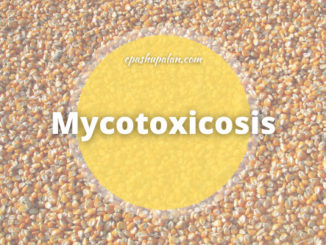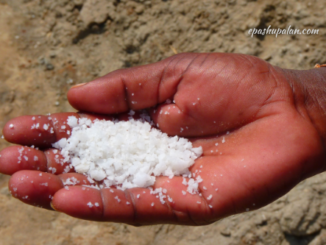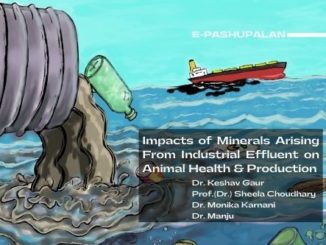Introduction
Heat or thermal stress can be defined as the point where the cow cannot dissipate an adequate quantity of heat to maintain body thermal balance. Temperature stress is a phenomenon that can impart physical and economical losses to livestock production in tropical and subtropical regions of the world. Temperature stressed animals undergo a series of metabolic and physiological changes (Berman, 2005). These changes are necessary for adaptability and survivability of the animal. Nutritional balance is an important factor in thermal stress which is deleterious to performance (Beede et al., 1983).

Thermal stress in livestock production results in increased demand for net energy for maintenance and subsequent reduction in energy for tissue growth and production (Ames et.al., 1994). Interactions between nutrition and heat stress results in nutrient deficiencies which affects animal’s ability to counter the stress. Thermal stress has negative effect on feed consumption and metabolic activities.
Changes in the thermal environment caused by variations in temperature, wind, humidity, precipitation and radiation induce a variety of physiological responses in animals. Wind is known to have a significant effect on heat loss from cattle (Webster, 1974).
All animals have a range of ambient environmental temperatures termed the thermo neutral zone. This is the range of temperatures that are conducive to health and performance. The upper critical temperature is the point at which heat stress effects begin to affect the animal.
The environmental conditions that induce heat stress can be calculated using the temperature humidity index (THI). There are a number of equations that have been used to calculate THI. These equations usually include temperature and humidity to calculate THI. One equation is:
THI = (Dry bulb temperature °C) + (0.36* dew point temperature °C) +41.2
Heat stress begins to occur in dairy cattle when the THI is > 72.
A number of changes occur in the animal as a result of heat stress. These include:
1. Elevated body temperature – Body temperatures > 102.5 °F (normal is 101.5 °F).
2. Increased respiration rates > 70-80/minute.
3. Increased maintenance energy requirement
Dairy cows will activate mechanisms in an attempt to dissipate the excess heat and maintain body temperature. The increased respiration rate is one example. The maintenance energy requirement may increase by 20-30 % in animals under heat stress. This decreases the energy intake available for productive functions such as milk production. Blood flow to the skin will increase in an attempt to dissipate heat. At the same time, blood flow to the core of the body will decrease.
Vasodilatation and increased blood flow to the skin in heat stressed animals help in the dissipation of excessive heat load. These changes result in reduction of blood supply to the internal organs including the ruminant forestomach. The blood to the digestive tract is greatly influenced by the level of feed intake, a factor which is related to the environmental temperature (Atterbery & Johnson, 1969). Increase in the energy requirement by thermally stressed animals significantly reduced protein efficiency ratio. Glucocorticoid level increase during heat stress (Collier et al., 1995). Association between circulatory glucocorticoids and proteolyitc activity in the digestive tract results in increased urinary nitrogen and creatinine excretion. Heat stress resulted in a reduced Metabolisable Energy (ME) production and nitrogen retention.
For efficient utilization of dietary protein during heat stress, protein intake should be adjusted in proportion to the expected reduction in average daily gain (ADG). A reduction in plasma triiodothyronine, decrease in body weight gain and poor feed conversion occurs in heat stressed animals when compared to animals in thermo neutral zone.
4. Feed nutrient utilization
An increased loss of sodium and potassium is usually associated with heat stress. This is due to losses associated with the increased respiration rate. This can shift the acid-base balance and result in a metabolic alkalosis. There can also be a decrease in the efficiency of nutrient utilization. At an environmental temperature of 40°C, there was a 28-fold increase in the urinary excretion of potassium compared to cows maintained at 15°C (Collier et al., 1995). Addition of dietary potassium and sodium salt has been reported to increase dry matter intake (DMI) and milk production in heat stressed dairy cows (Mallonee et al., 1993).
5. Dry matter intake
Dry matter intake (DMI) decreases in dairy cows subjected to heat stress. This depression in dry matter intake can be either short term or long term depending on the length and duration of heat stress. Decreases of 10 to 20 % are common in commercial dairy herds. A reduction in metabolic rate resulted in cattle exposed to heat stress. These responses helped in maintaining heat balance. Voluntary intake has been shown to be affected in feedlot cattle exposed to temperature above their thermo neutral zone (NRC, 2001). The reduction in DMI from roughage based diets becomes pronounced when environmental temperature increase is accompanied with high humidity (Bhattacharya & Hussain, 1993). The feed intake in intensively managed livestock is less affected by the heat stress compared to the grazing animals in which reduction in grazing activity is to maintain heat balance.
Thermal stress has an indirect relationship to feed intake. Heat stress induces alterations in the activity of the digestive system. The increase in environmental temperature has been associated with the reduced activity of the thyroid gland which results in reduced gut motility and rate of passage of digesta.
6. Milk production
There is normally a decrease in milk production for cows under heat stress. This decrease can be either transitory or longer term depending on the length and severity of heat If heat stress lowers milk production in early lactation dairy cows, potential milk production for the lactation will be decreased. Dairy cows in later lactation may recover slowly from the effects of heat stress (West, 2003).
7. Reproduction
Heat stress has also been reported to decrease reproductive performance in dairy cows. There are a number of changes in reproductive performance that have been reported. The effects on reproduction can be prolonged and impact the animal for months after the heat stress exposure. These include:
- The length and intensity of the estrus period decreases.
- Decreased conception (fertility) rate.
- Decreased growth, size and development of ovarian follicles.
- Increased risk of early embryonic deaths.
- Decreased foetal growth and calf size.
Factors Determining The Severity Of Heat Stress
The severity of heat stress experience by an animal depends on a number of factors. They include:
- The actual temperature and humidity.
- The length of the heat stress period.
- The degree of night cooling that occurs.
- Ventilation and air flow
- The size of the cow.
- The level of milk production and DMI prior to the heat stress (higher producing animals will experience greater effects of heat stress).
- Housing – type, ventilation, overcrowding, etc.
- Water availability.
- Breed
- Coat color (lighter color coats absorb less sunlight)
- Hair coat depth
Heat Dissipation In Cows
The animal has a number of mechanisms available to assist in trying to dissipate heat and maintain normal body temperature. These mechanisms include:
- Conduction – Heat moves from a warmer to a cooler surface. A cow needs direct contact with a surface for this to occur.
- Convection – The layer of air next to the skin is replaced with cooler air.
- Radiation – Heat can radiate from a warmer environment to a cooler environment.
- Evaporation – Sweat or moisture is evaporated from the skin or respiratory tract.
The cow can primarily control or regulate only the evaporative cooling mechanism. She has little ability to control the sensible losses (conduction, convection and radiation).
Nutritional Strategies To Counteract Heat Stress
There are a number of strategies to minimize the effect of heat stress on dairy cattle. The two primary options are making ration adjustments and altering the environment that the cow lives in (West, 1999).
1. Ration adjustments
The temptation of the dairy farmer is to increase the quantity of grain fed and decrease the quantity of forage in the ration to increase milk production. This shift will frequently induce rumen acidosis and impair cow health. Hence the goal is to adjust rations to increase energy and protein intake while maintaining rumen and cow health. The following strategies may be considered during dietary adjustments.
- Select and feed higher quality forages
- Lowering ration fibre (Acid Detergent Fibre (ADF) and Neutral Detergent Fibre (NDF) levels slightly while maintaining effective fibre levels (ADF 18% and NDF 28-30%) for optimum rumen function. This may require the use of some non-fibre by-product feeds such as soy hulls, beet pulp or citrus pulp.
- Addition of bypass fat to the ration. Total dietary fat levels should not exceed 5-5.5 % of total ration dry matter.
- Selection of feed ingredients with a high digestibility (bypass protein value of 40 %) in the animal. This lowers the heat produced by nutrient utilization within the animal.
- Balance ration protein levels to minimize high levels of soluble and rumen degradable protein. The animal must expend energy to excrete excess protein from the body.
- Adding buffers (sodium bicarbonate @ 0.75 % of daily diet DM, magnesium oxide, and sodium sesquicarbonate) to adjust rumen pH and help in maintaining a normal rumen environment.
- Increasing dietary potassium levels @ 1.2-1.5 % diet DM and sodium levels @ 0.4-0.6% of diet DM to counteract the higher potassium and sodium losses in heat-stressed cows. Dietary magnesium levels may also be increased by supplementation of magnesium oxide (MgO) @ 0.35-0.4 % of the diet DM.
- Addition of probiotic feed additives Saccharomyces cerevisiae (yeast) or Aspergillus oryzae cultures @ 0.1-0.25 % of the diet DM.
- Feeding a total mixed ration containing optimum ratio of roughages and concentrates (50:50) with a crude protein content not more than 17 %.
2. Feeding management
The feeding management practices used also offer opportunities for alteration in trying to minimize the effects of heat stress. Some of the key considerations in this area are:
- Fresh, palatable, high quality feed should be in the manger at all times to provide maximum opportunity for feed consumption. If the feed in the manger is warm, musty or spoiled, it needs to be removed and discarded.
- Uniform mixing and delivery of rations on a daily basis.
- Provision of separate manger for each cow.
- Addition of water or molasses may help the feed stick together better.
- It may be useful to shift feeding times to match cow behaviour. Cows tend to change meal patterns and eat more fibrous feed like roughages and protein rich concentrates during the cooler times during of the day and during night hours.
- Provision of adlibitum clean and fresh drinking water throughout the day and after milking.
- There should be at least 2-3 inches of water space per cow.
- Provision of more than 1 watering device for each group of cows may encourage water consumption and decrease competition.
3. Housing and facility adjustments:
- Minimize overcrowding of cows.
- Provision of shade to cows reduces the effect of radiation.
- Proper ventilation with the addition of fans will be required to assist in increasing air flow.
- Provision of misters or sprinklers to increase evaporative cooling by wetting the skin. The goal is to wet the cow not soak the cow.
Summary
Thermal stress exerts an influence on livestock productivity through an interaction between the animal’s physiological changes and the energy requirement. Adjusting the dietary protein during thermal stress to estimated level of reduction in the average daily gain would be economically efficient. Adequate feeding and housing management systems could be devised that are climate and animal type specific and that would establish optimum body condition during appropriate periods of the year. These could optimize the efficiency of using stored fat in minimizing maintenance energy requirements and maximize the economic efficiency of productive livestock.
References
- Ames, D.R., Brink, D.R. and Williams, C.L. 1994. Adjusting protein in feedlots diets during thermal stress. J. Anim. Sci. 72:598-605.
- Atterbery, J.I. and Johnson, H.D. 1969. Effects of environmental temperature controlled feeding and fasting on rumen motility. J. Anim. Sci. 29: 734-737.
- Beede, D.K., Mallonee, P.G., Schneider, P.L., Wilcox, C.J. and Collier, R.J. 1983. Potassium nutrition of heat stressed lactating dairy cows. South African J. Anim. Sci. 13: 198-206.
- Berman, A. 2005. Estimates of heat stress relief needs for Holstein dairy cows. J. Anim. Sci. 83:1377-1384.
- Bhattacharya, A.N. and Hussain, F. 1993. Intake and utilization of nutrients in sheep fed different levels of roughage under heat stress. J. Anim. Sci. 71: 1761-1766.
- Collier, R.J., Beede, D.K., Thatcher, W.W., Israel, L.A. and Wilcox, C.J. 1995. Influences of environment and its modification on dairy animal health and production. J. Dairy Sci. 78: 2221-2229.
- Gengler, W.R., Martz, F.A., Johnson, H.D., Krause, G.F. and Hahn, L. 1968. Effects of temperature on food and water intake and rumen fermentation. J. Dairy. Sci. 53: 434-440.
- Mallonee, P.G., Beede, D.K., Collier, R.J. and Wilcox, C.J. 1993. Production and physiological responses of dairy cows to varying dietary potassium during heat stress. J. Dairy. Sci. 76: 819-825.
- NRC [National Research Council]. 2001. Nutrient Requirements of Dairy Cattle. 7th rev. Ed. National Academy Press, Washington D.C., 401p.
- Webster, A.J.F. 1974. Prediction of heat losses from cattle exposed to cold outdoor environments. J. Appl. Physiol. 30: 634-643.
- West, J.W. 1999. Nutritional strategies for managing the heat-stressed dairy cow. J. Anim. Sci. 77:21-35.
- West, J.W. 2003. Effects of heat stress on production in dairy cattle. J. Dairy Sci. 86: 2131- 2144.






1 Trackback / Pingback